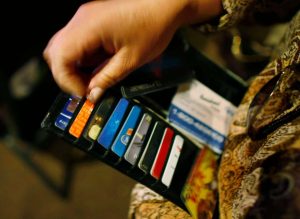Canadians are paying down debt during COVID-19 — but a ‘tsunami’ of bankruptcies could be coming

The ratio of what Canadians owe versus their ability to pay it back went down in the first three months of COVID-19, but that unexpectedly brighter debt picture could be hiding a wave of bankruptcies waiting to emerge.
Statistics Canada reported Friday that the debt to disposable income ratio fell to 158.2 per cent in the three months between April and June, compared with a reading of 175.4 per cent in the first three months of the year.
That means that Canadian households owed $1.58 for every dollar they had to spend as of the end of June. That ratio peaked at 177 per cent in 2017 and has held steady in the 170 range up until the sudden drop this year.
While it’s encouraging to think that Canadians are managing to pay down their debt loads during the pandemic, insolvency trustee Scott Terrio with Hoyes & Michalos says the numbers mask what’s happening beneath the surface.
Prior to the pandemic’s start in March, consumer insolvencies had been growing at a double-digit pace since the start of 2019 as the system worked through a decade of debt fuelled by a low rate that Terrio said people “binged” on “and kicked the can down the road.”

Then like almost everything else, insolvencies came to a screeching halt starting in March. Part of that was because courts shut down, making it hard for debtors to take legal action to get their money back.
But the massive wave of support programs rolled out by governments across the country seem to have had their designed effect of keeping peoples’ heads above water, too.
While the record number of layoffs made a dent in incomes, many people who were in trouble before COVID-19 got some relief simply because they weren’t spending as much.
As daycares shut down and parents moved to work from home en masse, “all of a sudden, people weren’t paying $2,000 a month in daycare for five months,” Terrio said.
In addition to government stimulus, roughly one out of every six Canadian homeowners with a mortgage applied for programs that banks offered to defer all or part of payments for up to six months this spring. But those programs are slated to end in the coming weeks, and those bills have to be paid.

“The ones I’m worried about are the ones who had significant debt and then one of the spouses stopped working,” he said.
“They’ve taken advantage of deferrals and benefits [but] that ride is gonna end.”
Savings up sharply, too
All told, Canadians owed $2.3 trillion at the end of June, which consists of $1.5 trillion worth of mortgages, and $779.4 billion worth of consumer debt such as credit cards.
The Statscan numbers show the debt picture is changing very unevenly across different income groups.
The lowest 20 per cent had a debt to income ratio of 281.7 per cent at the end of June, meaning they owed almost $3 for every dollar they had on hand to spend. Those in the top 20 per cent, meanwhile, had a ratio of 139.8 per cent.
Those imbalances are part of why Terrio predicts that insolvencies are going to come back “with a vengeance ” in the coming months.
“Once the courts open you’ll find how much your bank loves you,” he said.
‘Delinquency tsunami’
TD Bank economist Ksenia Bushmeneva found reasons for optimism in the numbers.
“One of the major risks heading into this pandemic-induced recession was the high level of household indebtedness in Canada, which could greatly amplify the hit to the economy and slow the subsequent recovery,” she said.
“So far, it appears that the consumer side of the economy has held up better than might have been expected at the start of the crisis.”
Bushmeneva was especially heartened by the fact that the debt service ratio — the amount of money spent on servicing debt loads — fell by its highest amount on record, to 12.4 per cent from 14.54 per cent, largely because of lower rates.
In addition, she noticed that the household savings rate — the percentage of income that households manage to save — soared from 3.9 per cent at the end of 2019 to 28.2 per cent in June, a level she described as “eye popping.”
But she is also worried about what could be coming down the pipeline.
“The unprecedented federal government income support programs and payment deferrals by financial institutions have been paramount for averting a delinquency tsunami and protecting household finances,” she said. “However, more challenging times are likely ahead.
“Delinquencies and consumer insolvencies will likely begin to rise at the end of this year and into 2021.”








Redes Sociais - Comentários